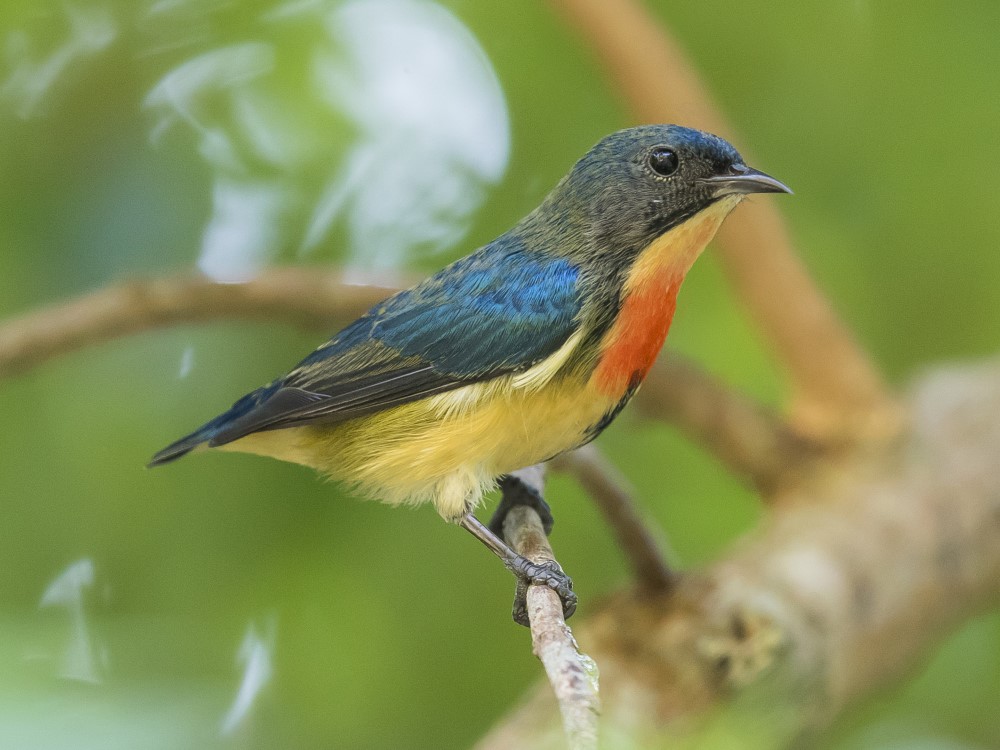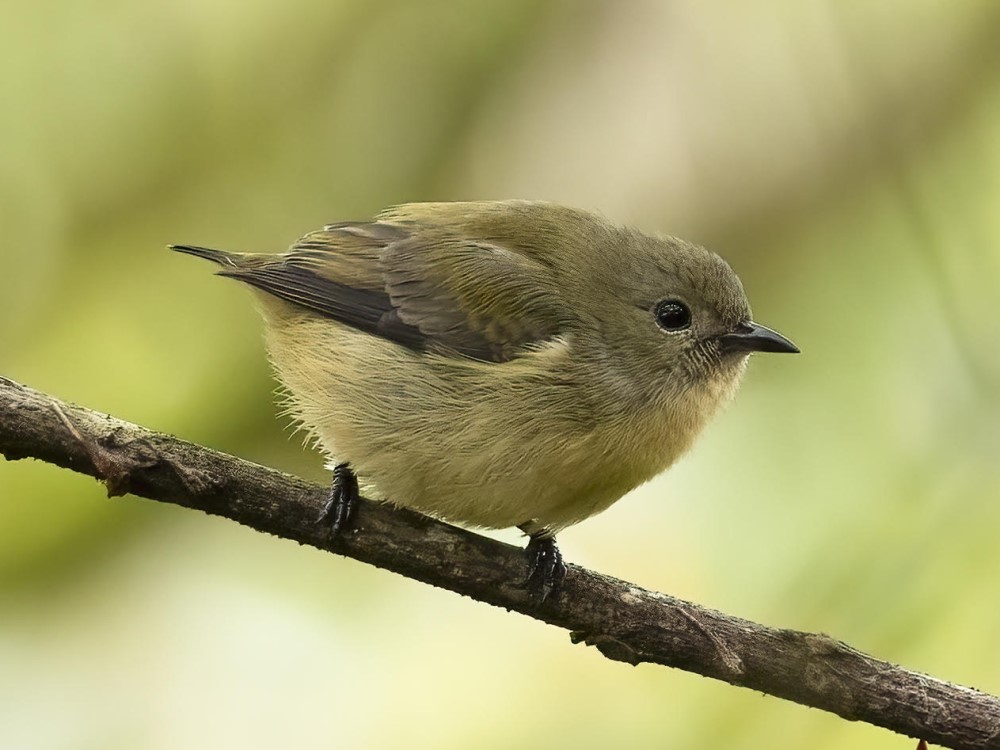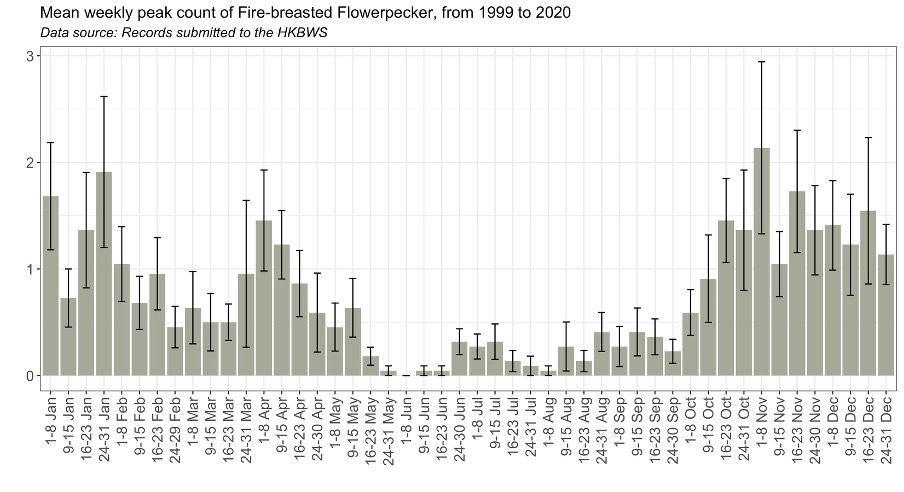Fire-breasted Flowerpecker Dicaeum ignipectus 紅胸啄花鳥
Category I. Scarce but widespread winter visitor and rare breeding species.
IDENTIFICATION

Nov. 2019, Matthew Kwan. Male.
7-9 cm. The male has somewhat shining blue wing coverts and tertials, duller greyish flight feathers and blue upperparts that sometimes contrast with a turquoise rump. The sides of the chest are greyish and contrast with the throat, which is washed pinkish-orange. Below the flame-coloured chest and intruding into it is an irregular blackish vertical line.

Jan. 2023, Patrick Lo. Female.
The female is medium olive-grey above (less brown than Scarlet-backed Flowerpecker), greyer on the head and more olive on the rump and uppertail coverts. The underparts are buff, with a moderately well-marked division formed below the ear coverts. Unlike Scarlet-backed Flowerpeckers, juveniles lack a largely or wholly orange bill, instead having a pale base that darkens fairly rapidly.
VOCALISATIONS
Fire-breasted Flowerpecker utters four types of vocalisation (terminology follows Kirwan and Boesman 2023). The ‘seesaw song‘ is given from at least May to October and consists of a series of pairs of notes that usually, though not always, comprise one higher in pitch the second lower. It differs from the seesaw song of Scarlet-backed Flowerpecker in being slightly shorter in duration, slightly higher in pitch, slightly faster in pace and in each phrase containing more elements. On some birds, mostly younger males, the song is somewhat degraded and flatter, with the ‘seesaw’ element much reduced.
The ‘chik’ call is usually uttered in flight but also when perched. As a simple, extremely short broadband sound, it is difficult to distinguish from the equivalent call of Scarlet-backed Flowerpecker. However, it may sound slightly higher-pitched and thinner. When perched, this call may be uttered by young males in rapid sequence when it sounds like a poorly-developed ‘rising twitter’.
The ‘rising twitter’ differs from the equivalent vocalisation of Scarlet-backed in being more forceful and assured, in containing more elements and introductory notes and in comprising longer phrases that are more uniform in tone. The basic element of this call is the ‘chik’ described above.
Young males may give a version that is largely ‘twitter’ without the rise or may simply consist of a series of ‘chik’ notes.
The ‘tseet’ call is very similar to that of Scarlet-backed Flowerpecker but seems to be uttered much less frequently, though more often when males are squabbling.
DISTRIBUTION & HABITAT PREFERENCE
Fire-breasted Flowerpecker is more strictly a forest species than the other two flowerpeckers occurring in HK. In comparison with Scarlet-backed Flowerpecker, a higher proportion of records occur in extensive forest areas such as Tai Po Kau and Shing Mun, and it is less commonly found in fung shui woods and village areas. In areas such as Tai Po Kau, where both species occur, Fire-breasted Flowerpeckers are more often found in the heart of the forest, but both species can be found together and often interact aggressively in defence of favoured feeding sites such as clumps of Oriental Mistletoe Viscum ovalifolium.
OCCURRENCE
The Fire-breasted Flowerpecker is predominantly a winter visitor to HK and, as Figure 1 shows, most birds arrive between early October and mid-November. Whilst certain sites, in particular Tai Po Kau, are especially favoured, wintering birds are widespread and Fire-breasted Flowerpeckers are regularly seen in forested areas on HK Island such as Mount Austin, Mount Davis and Aberdeen CP. This distribution contrasts with that of Scarlet-backed Flowerpecker, which is rare on the Island, even in winter. Departure in spring is less well marked, with numbers apparently declining in February and March, but the picture is obscured by the presence of a small breeding population that presumably is responsible for the upsurge in records in April.
The first midsummer records of this species occurred during 20-21 June 1975 when a pair was seen at Mount Austin, and there were occasional records of singing birds in summer in Tai Po Kau during the 1980s. The first confirmed breeding record occurred in 1990, when a pair and two young were seen in Aberdeen CP on 7 April. Subsequently, summer records have been annual, mostly at Tai Po Kau where breeding was proven again in 1995, but also at Cape D’Aguilar, Sai Kung and Shuen Wan, with suspected breeding at the latter site in 1996. In view of the low level of observer activity in HK in the summer months and the large areas of forest in the central New Territories it is likely that breeding is now annual.
Though it has long been known as a widespread breeding species in southern China (La Touche 1925-30), Fire-breasted Flowerpecker was unknown in HK until 1954 when one observer saw birds at different locations in the central New Territories in January, May and December (Herklots 1967). The coincidence of the same observer being responsible for the first three records strongly suggests that this species had previously been overlooked and, indeed, it was subsequently recorded almost annually. There was apparently a sudden upsurge in the number of records from 1966, which it is now difficult to explain, but may well be due to increased observer familiarity with the species.
BREEDING
The first confirmed breeding record occurred in 1990, when a pair and two young were seen in Aberdeen CP on 7 April. While there are reports of a juvenile moulting into male plumage and of single juveniles, there are no unequivocal reports of breeding having occurred in HK this century.
BEHAVIOUR, FORAGING & DIET
Fire-breasted Flowerpecker may be seen at parasitic plants such as Oriental Mistletoe Viscum ovalifolium, but it also forages on small tree fruit such as Chinese Hackberry Celtis sinensis, perhaps to a greater degree than Scarlet-backed Flowerpecker.
RANGE & SYSTEMATICS
Distributed from the western Himalayas east to south China and south through Indochina to Vietnam and Thailand away from the peninsula, with an isolated population in Malaysian hills (Kirwan and Boesman 2023). In China occurs in coastal provinces from Fujian west and in Yunnan and southwest Sichuan (Liu and Chen 2021).
CONSERVATION STATUS
IUCN: Least Concern. Population decreasing.
Figure 1.

Herklots, G. A. C. (1967). Hong Kong Birds (2nd ed.). South China Morning Post, Hong Kong.
Kirwan, G. M. and P. F. D. Boesman (2023). Fire-breasted Flowerpecker (Dicaeum ignipectus), version 1.0. In Birds of the World (N. D. Sly and S. M. Billerman, Editors). Cornell Lab of Ornithology, Ithaca, NY, USA. https://doi.org/10.2173/bow.fibflo1.01
La Touche, J. D. D. (1925-30). Handbook of the birds of Eastern China Vol. 1. Taylor and Francis, London.
Liu, Y. and S. H. Chen (eds) (2021). The CNG Field Guide to the Birds of China (in Chinese). Hunan Science and Technology Publication House, Changsha.

